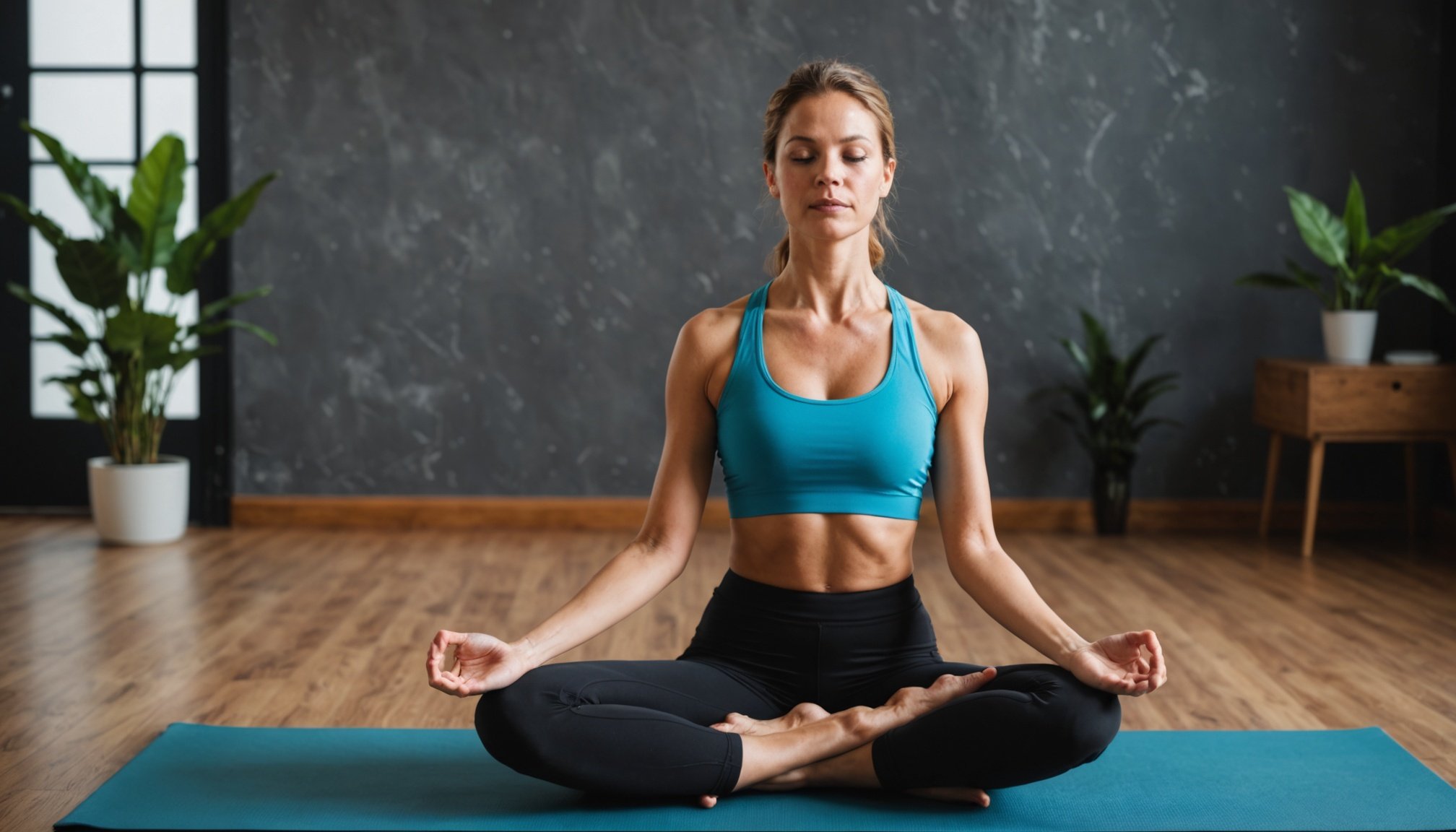Overview of Yoga Techniques for Stress Relief
Yoga for Stress Relief offers a holistic approach to alleviating tension and anxiety. Mindfulness Yoga Techniques play a crucial role by encouraging present-moment awareness, a key factor in reducing stress. The practice involves various styles, each offering unique benefits. Let’s explore how these techniques work.
Yoga aids stress reduction primarily through deep breathing and gentle movements, which activate the body’s relaxation response. This, in turn, helps lower cortisol levels, the hormone associated with stress. Among the different styles, Hatha yoga, with its slow-paced and calming poses, is particularly effective for beginners. Vinyasa flow combines movements with breath, while Restorative yoga focuses on deep relaxation and holding poses for longer durations.
This might interest you : Low-Impact Cardio for Women: Discover Gentle Workouts to Stay Active Without Joint Pain!
Mindfulness, at the core of yoga, enhances the practice’s effectiveness. By being present and aware, individuals learn to manage stress proactively. During sessions, practitioners are encouraged to focus on their breath and bodily sensations, creating a calming effect on the mind and body.
Incorporating these Yoga techniques into your routine can significantly improve mental health, making them a valuable tool in stress management.
Also read : Unlock Your Glow: Master the Art of Highlighter Application with Expert Tips for a Stunning Radiance
Beginner-Friendly Yoga Techniques
Introducing Beginner Yoga into your routine can have a profound impact on stress relief. Simple poses provide accessible methods for achieving relaxation and calmness.
Child’s Pose
Child’s Pose is a gentle resting posture that encourages deep breathing and relaxation. Kneel on the floor, sit back on your heels, then reach forward with your arms extended. Hold this pose to relieve tension in the back and shoulders.
Cat-Cow Stretch
The Cat-Cow Stretch combines two poses that elevate flexibility and alleviate stress. Begin on all fours, then arch your back up like a cat and dip it down like a cow, synchronising each movement with your breath. This sequence soothes the spine and enhances mindfulness.
Legs-Up-the-Wall Pose
To relax with the Legs-Up-the-Wall Pose, lie on your back with your buttocks close to a wall, lifting and resting your legs vertically. This inverted position calms the nervous system and reduces stress-induced swelling in the legs.
Enhancing relaxation involves focusing on slow, deep breaths during each pose. Consistent practice of these beginner-friendly techniques cultivates an approachable path to managing stress effectively.
Advanced Yoga Techniques for Stress Relief
For those familiar with basic poses, Advanced Yoga offers deeper relaxation through Deep Stretching Techniques. The benefits of these advanced methods are profound, providing a deeper connection and releasing stored tension.
Restorative Yoga Poses
Restorative yoga focuses on passive stretching by holding poses for extended periods, allowing muscles to relax. This approach targets deep-seated stress, encouraging a meditative state. Typical poses include the Supported Child’s Pose and Reclining Bound Angle Pose, which use props like bolsters or blankets for support, enhancing comfort and relaxation.
Pranayama (Breathing Techniques)
Pranayama involves breathing exercises that regulate and deepen breath, a crucial element in Advanced Yoga. Techniques like the Ujjayi breath or Nadi Shodhana promote relaxation, reduce anxiety, and improve concentration. Practitioners often feel a sense of calm and mental clarity post-session, thanks to the controlled, mindful breathing patterns.
Yoga Nidra
Often described as ‘yogic sleep,’ Yoga Nidra is a meditative practice that induces profound relaxation and detachment from stress. By guiding practitioners into a semi-conscious state, it lowers heart rate and reduces cortisol production. This technique is praised for its ability to alleviate chronic stress and promote mental peace, making it an invaluable tool for stress relief.
Creating a Personalized Stress-Relief Routine
Crafting a Personalized Yoga Routine can greatly enhance stress management by addressing individual comfort and goals. To begin, consider your current stress triggers and personal preferences when selecting yoga poses. This customization ensures that your practice is both enjoyable and effective, catering to your unique needs.
Consistent practice is fundamental in maximising the benefits of yoga. Regularity fosters habit formation and leads to a sustained reduction in stress levels. Scheduling regular sessions, even if brief, can make a significant difference in your overall well-being.
Incorporating mindfulness and meditation into your routine enhances relaxation and concentration. This can involve starting or ending your session with a few minutes of focused breathing or meditation, reinforcing the connection between mind and body.
By tailoring your yoga practice to suit your lifestyle, it becomes easier to integrate into a busy schedule, ensuring that stress relief becomes a natural and rewarding part of your daily life. Remember, the key is to create a routine that feels right for you, promoting a sense of calm and balance.
The Role of Mindfulness in Yoga
Integrating mindfulness with yoga practice can significantly enhance the experience and effectiveness of stress relief. Understanding this connection begins with an exploration of mindfulness principles.
Definition of Mindfulness in the Context of Yoga
Mindfulness in yoga refers to a deep state of awareness where the practitioner is fully present in the moment. This involves focussing on breath and body sensations, cultivating an inner calm and clarity that allows stress to dissipate.
Techniques for Enhancing Mindfulness During Yoga
To enrich your mindful yoga practice, concentrate on the following techniques:
- Begin each session with a short breathing exercise to centre your mind.
- Keep attention on your breath throughout, letting it guide movements.
- Use body scans to sense tension and consciously release it.
Benefits of Mindful Yoga Practice
Practising mindful yoga offers numerous benefits, including enhanced relaxation, improved concentration, and a reduction in anxiety. Research shows that regular mindful practice increases adaptability to stress, making it an invaluable approach to maintaining mental harmony. By integrating mindfulness into your routine, you harness the full potential of yoga as a therapeutic tool for stress management.
Visual and Guided Resources
Tap into the power of Yoga Videos and Guided Yoga Sessions to elevate your stress relief practice. Online platforms offer a wealth of resources tailored to diverse skill levels, whether you’re dipping your toes into beginner yoga classes or refining your advanced techniques.
Yoga Videos are beneficial as they allow you to learn at your own pace, offering visuals and instructions that help clarify poses and breathwork. This becomes particularly useful when attempting complex sequences or unfamiliar styles. Guided Yoga Sessions, on the other hand, provide a structured format that encourages you to stay committed. An instructor’s guidance can enhance your progress, making each session more rewarding.
The benefits of such guided resources extend beyond just understanding postures; they also foster a deeper connection. When practitioners engage with visual aids, they often find it easier to maintain correct form and prevent injury. Additionally, these resources help bridge the gap between home practice and studio experience, providing a supportive framework to explore stress-relief techniques thoroughly.
Integrating Yoga Techniques into Daily Life
Incorporating Daily Yoga Practice into your routine can be transformative, integrating Lifestyle Changes for Stress Relief into your everyday activities. To weave yoga seamlessly into a busy schedule, start with short, manageable sessions, allowing yoga to complement rather than disrupt your daily commitments.
Here are some tips:
- Morning Energiser: Start your day with a brief yoga session to invigorate your mind and body.
- Office Break: Use breaks to perform simple stretches at your desk, easing physical and mental tension.
- Evening Wind-Down: Conclude your day with calming stretches to transition into a restful state before sleep.
Adopting a stress-relief mindset involves integrating mindfulness throughout the day. Pause regularly to focus on deep breathing, especially during stressful moments, to reclaim equilibrium. Additionally, engaging with community and support groups provides a shared space for encouragement, accountability, and growth in your yoga journey, enriching your practice.
These collective strategies foster an ongoing commitment to stress management, allowing yoga to serve as a powerful ally in maintaining mental and emotional well-being. By embedding these techniques into your daily life, yoga becomes not just an activity, but a lifestyle shift towards balance and peace.











